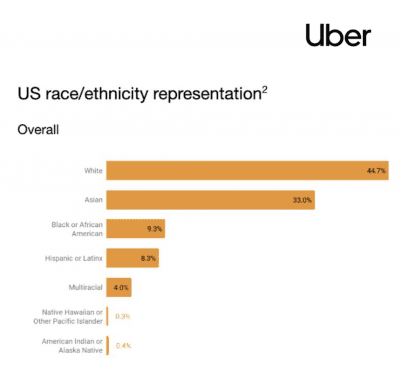And to get there the tech giant has implemented “progress on measurable D&I (diversity and inclusion) goals” as a key metric evaluating the job performance of its most senior leaders, linking such performance to executive compensation.
The specific KPIs that have been established for several of its executives include moving the proportion of Uber’s L5 (manager and above) leadership to above 35 per cent by 2022, and to grow underrepresented employees at lower levels to over 14 per cent.
Report author, Uber’s first chief diversity officer Bo Young Lee, says the goal is to make Uber, “the most diverse, equitable, and inclusive workplace on the planet”.
“Creating the most diverse and inclusive workplace on the planet won’t be possible if we settle for small, incremental changes,” Lee writes in the report.
“Realizing Uber’s bold vision will require bold actions to match—starting with a complete shift in how Uber works as a company. For us, that began with fundamentally transforming our culture.”
She adds Uber has “certainly made mistakes” in the past, but has learned a lot of lessons too.
The appointment of Lee in early 2018, shortly after its new CEO Dara Khosrowshahi, marked a significant shift for Uber in addressing some of the very public concerns regarding culture that have plagued the ride-sharing company.
In 2017, ex-Uber engineer Susan Fowler published a widely shared blog detailing how she had repeatedly made complaints about discrimination and sexual harassment during her time with the company.
An internal investigation by former US Attorney General Eric Holder recommended Uber undertake a management overhaul, publish diversity stats, target diverse sources of talent, and elevate the visibility of a head of diversity to report direct to the CEO or COO, among other things.
Lee was previously with financial services firm Marsh and is well acquainted with achieving cultural change. As she says, “finance was a bro culture before tech had one”
Speaking with Women’s Agenda earlier this year, she said that she’s dedicated her life to diversity and inclusion since grad school. When she took the call from Uber about heading up their diversity efforts, she saw it as an opportunity to achieve great change in the organisation. She added that upon starting with Uber, she immediately saw a strong commitment from the very top to make change happen.
The diversity report shows the rate of women in leadership has improved, rising from 20.9 per cent to 28 per cent over the past year, something CEO Khosrowshahi said he’s proud of on announcing the figures earlier this week. But he then conceded that he’s not proud of the rate of change for people of colour. He added such representation has to get better, but they are “early in this process.”
Globally, Uber had around 26,000 employees in March 2019, a massive leap from 18,000 at the same time last year. This figure does not include drivers.
Women make up 40.9 per cent of women overall in the company, with 44. per cent of the workforce white, 33 per cent Asian, 9.3 per cent black or African American, 8.3 per cent Hispanic of Latinx and 4 per cent multiracial.
In Australia and New Zealand, Uber is led by two women, with Jodie Auster at the helm of Uber Eats and Susan Anderson leading Uber drive. Australia continues to be one of the most gender diverse locations for Uber, with more than 40 per cent of its 550-strong local workforce female, including five of its eight executive team, according to 2018 stats published by the AFR.
As well as linking targets to pay, Uber has also asked all team member to set a “personal citizenship performance goal” aimed at helping to improve their communities in and outside the company.
It is piloting sponsorship, mentoring and coaching programs at all levels, has undertaken a ‘Global Self ID’ survey asking employees to voluntarily share how they identify in order to better support those already represented in its workforce, developed Gender Transition Guidelines and established workshops on unconscious bias.
In aiming to improve diversity in new hires, Uber is piloting the ‘Rooney Rule’ for mid career hires. The rule is a policy of the National Football League in the United States that requires league teams to interview ethic-minority candidates for senior football and head coaching positions.
Uber is also aiming to further improve how it supports parents and caregivers, offering a certified practitioner dedicated to every new parent to ease the transition back to work. It currently offers 18 weeks of full pay parental leave to employees globally.
“In the year ahead, we’ll keep expanding established D&I initiatives, laying the groundwork for new programs, and pioneering innovative strategies for sharing what we learn with others. We won’t stop until diversity and inclusion are embedded at the core of everything we do,” Lee concludes in the report.




